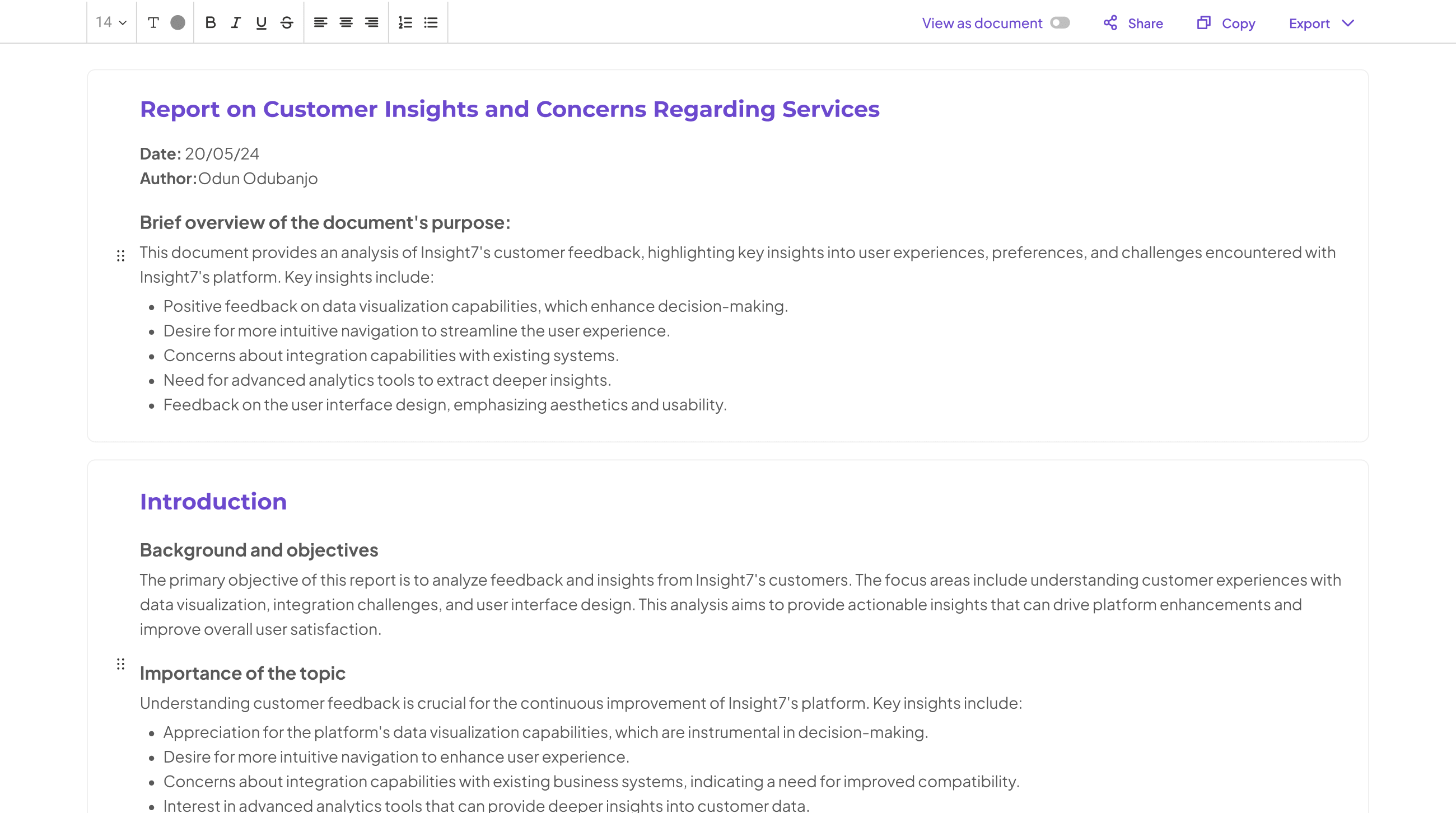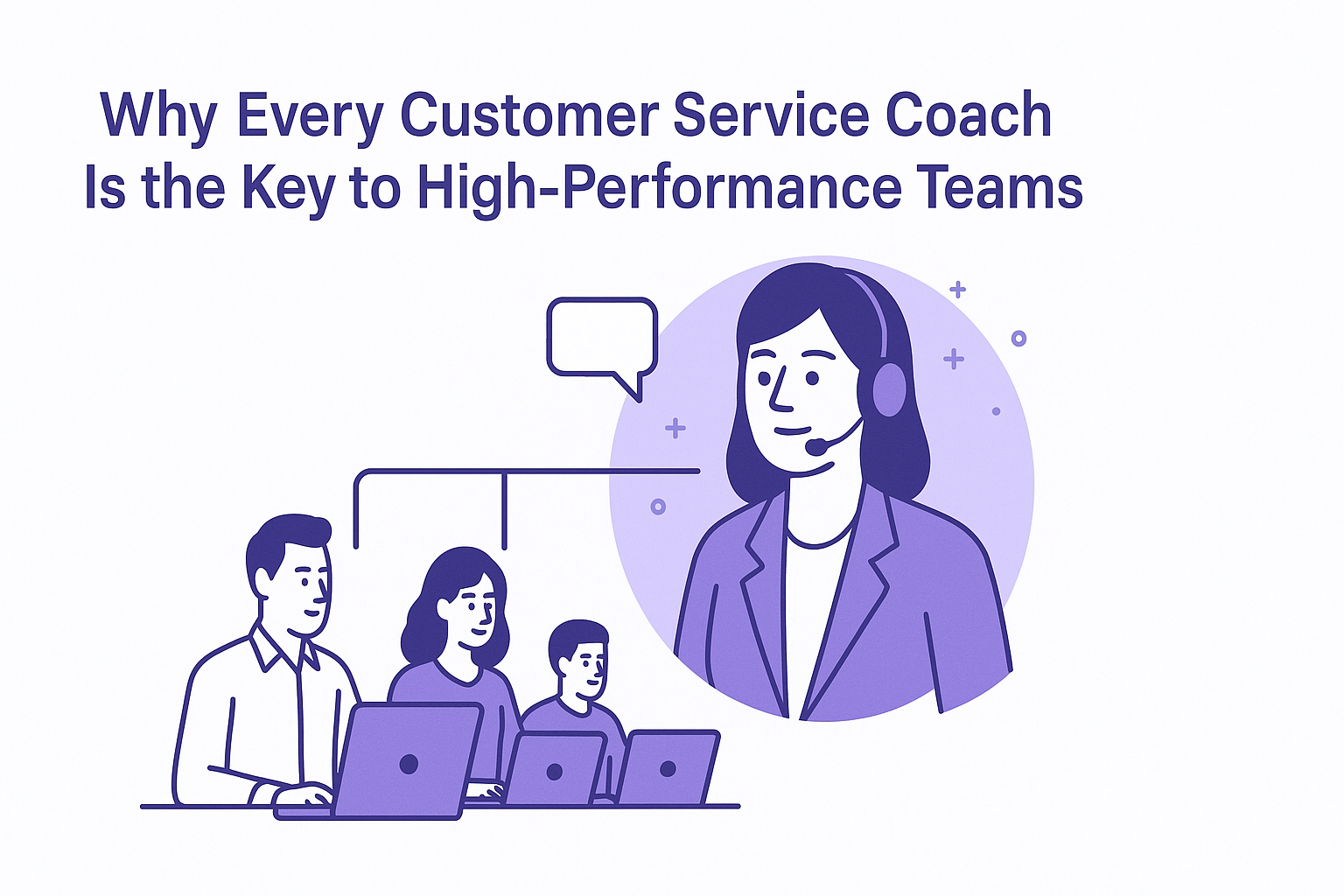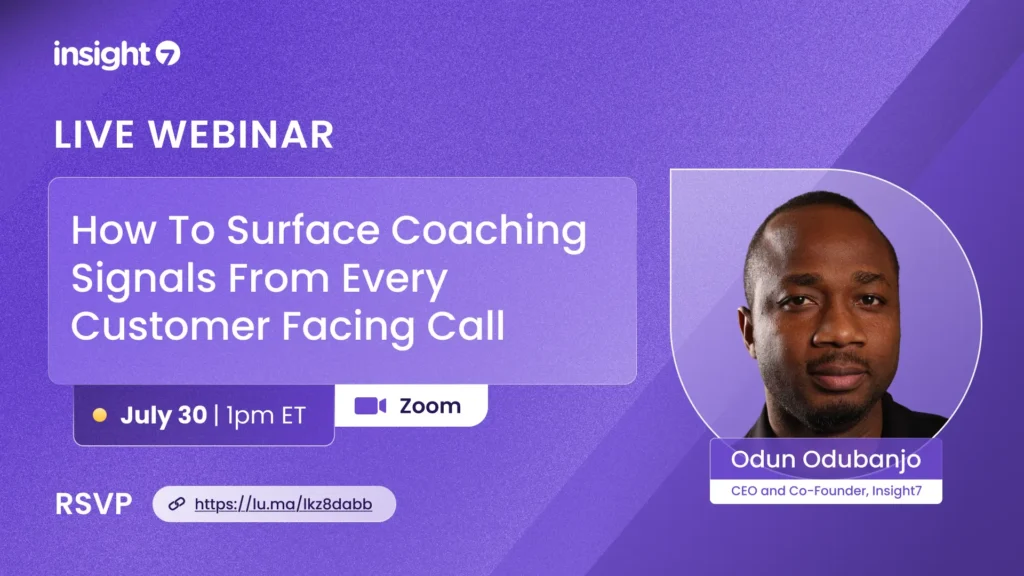How to generate reports from customer interviews
-
Hello Insight
- 10 min read
In today’s rapidly evolving market, generating interview reports is essential for organizations striving to meet customer expectations. Interview report generation transforms raw conversations into structured insights, providing invaluable information for decision-making. By comprehensively analyzing customer feedback, businesses can uncover critical pain points and desires that shape their offerings effectively.
Understanding the nuances of interview report generation can significantly enhance your strategy. By implementing a systematic approach, such as accurate transcription and data analysis, you ensure that the generated reports are not only helpful but also actionable. This section will explore the methods and tools that can streamline this process, allowing your organization to derive maximum value from customer insights and effectively adapt to their needs.
In the competitive landscape of customer experience management, generating insightful reports from customer interviews is vital. This process not only aids in understanding customer needs but also enhances business strategy.
Generating insightful reports from customer interviews is critical in customer experience management. This process plays a significant role in decoding customer needs, allowing organizations to grasp their preferences and concerns effectively. By converting raw interview data into structured reports, businesses can derive actionable insights that directly inform their strategic goals. In a market filled with rapidly changing demands, translating these insights quickly can provide a competitive edge.
To successfully produce these reports, it is essential to understand the methodologies involved. Start by defining clear objectives for your interviews to ensure the data collected is relevant. Next, create a structured interview guide with targeted questions designed to elicit valuable responses. Recording and transcribing interviews accurately is crucial for maintaining the integrity of the data. By following these steps, businesses can confidently move from customer insights to informed business strategies, ultimately enhancing their service offerings and fostering customer loyalty.
Transcribe & extract insights from interviews. At Scale.

Collecting and Analyzing Interview Data for Report Generation
In the realm of interview report generation, collecting and analyzing data effectively is crucial for deriving valuable insights. Start by clearly identifying your objectives, as this sets the stage for focused discussions. Next, create a structured interview guide that complements those objectives, ensuring your questions are precise and actionable. This preparation minimizes ambiguity and maximizes the quality of the information gathered during the interviews.
Once interviews are conducted, meticulous transcription of the recorded conversations is paramount. This allows you to capture essential nuances and themes that emerge from the discussions. Analyze this data thoughtfully by employing different organizational methods, such as thematic coding or matrices, to highlight prevalent trends. The insights you uncover should not only summarize key pain points but also connect customer feedback directly to your business strategies. With comprehensive and structured approaches, you're better equipped to turn raw data into impactful reports that inform decision-making and enhance customer experiences.
Preparing for Effective Interview Report Generation
To prepare for effective interview report generation, it's essential to establish a clear and focused framework before diving into the actual interviews. Begin by defining your objectives; identifying what you hope to achieve ensures your interviews are purposeful and aligned with your business goals. This clarity will serve as the foundation for developing your interview guide, allowing you to craft questions that will yield valuable and actionable insights.
Additionally, structuring your interview process can significantly enhance the quality of the data you collect. By creating a structured interview guide, you can ensure that all relevant topics are covered and facilitate a smooth interaction with interviewees. This preparation not only helps in gathering rich information but also streamlines the subsequent reporting process. With a well-defined approach in place, you will be better equipped to generate reports that truly reflect the voices and needs of your customers.
- Step 1: Define Your Objectives
Defining your objectives is the cornerstone of a successful interview report generation process. Before conducting interviews, take time to assess what you hope to learn and how that information will be utilized. Establishing clear objectives helps guide the conversation and aligns both the interviewer and interviewee on the topics of discussion. Such clarity maximizes the value of the insights gathered and ensures they serve specific needs.
Identify key themes to explore, such as customer experiences, pain points, or preferred features. Once defined, these objectives will inform the structure of your interview questions, shaping how you capture meaningful data. In essence, knowing your goals transforms interviews from mere data collection into strategic discussions that drive decision-making and enhance customer understanding. This focused approach not only improves the quality of your insights but also helps in generating reports that are actionable and relevant.
- Establish clear goals and expectations for the interview process.
Establishing clear goals and expectations for the interview process is crucial in generating meaningful reports. Begin by defining specific objectives that guide the interviews, focusing on what information you want to extract. Clear objectives ensure that all participants understand the purpose of the interviews, which significantly enhances the quality of insights gathered.
Additionally, setting expectations creates a framework for consistency throughout the process. This includes determining the types of questions to ask, how responses will be recorded, and the data analysis methodology. A well-defined workflow ensures that the interview not only captures necessary details but also aligns with the overall aim of interview report generation. By laying this groundwork, you increase the likelihood of producing insightful and actionable reports that can inform strategic decisions.
Collecting and Analyzing Interview Data for Report Generation
Interview report generation starts with effective data collection strategies. The process begins by defining clear objectives to guide your interviews. This step ensures that you focus on relevant topics that are essential for your analysis. Next, developing a structured interview guide is crucial. By preparing well-aligned questions, you facilitate precise data collection, making your subsequent analysis more straightforward.
After you conduct the interviews, it's essential to record and transcribe the conversations accurately. This thorough transcription aids in capturing nuanced insights and helps in the detailed analysis of customer feedback. To enhance the quality of your report, employ tools like Dovetail for organizing qualitative data, and Rev.com for reliable transcription services. These steps in interview report generation are fundamental for translating qualitative insights into actionable business strategies. Ultimately, well-structured reports can significantly influence decision-making within an organization.
- Step 2: Develop a Structured Interview Guide
Creating a structured interview guide is essential for effective interview report generation. Start by defining your objectives, as this will inform the questions you develop. Your guide should consist of open-ended questions that encourage detailed responses while allowing the flexibility to explore interesting points raised by participants. This structure not only keeps the conversation focused but also ensures that you gather rich, relevant data.
Consider including key areas of inquiry that align with your overall goals. For instance, you might want to include sections on customer pain points, product usability, and overall satisfaction. Each category should have probing questions that delve deeper into user experiences. By preparing these questions in advance, you can facilitate a smoother interview process, leading to more insightful reports that effectively capture the essence of customer feedback.
- Prepare questions that align with your objectives to facilitate precise data collection.
To facilitate precise data collection during customer interviews, it's essential to prepare questions that genuinely align with your objectives. This clarity ensures that you gather relevant insights that reflect customer experiences and attitudes. When crafting your questions, start by identifying the specific goals of the interview. For instance, what information do you aim to uncover? Tailor your inquiries to elicit detailed responses that reveal customer motivations and preferences.
Next, incorporate open-ended questions that encourage interviewees to share their thoughts extensively. Additionally, consider including probing questions to dive deeper into their responses. These can lead to valuable insights that strengthen the resulting Interview Report Generation. A well-structured approach not only enhances the quality of the information collected but also promotes a more engaging interaction. By focusing on these elements, you'll be better equipped to analyze the data and generate meaningful reports that inform your business strategies.
Data Collection and Transcription for Interview Report Generation
The process of data collection and transcription is vital for effective interview report generation. First, it is essential to record the interviews accurately to ensure all insights are captured faithfully. Using high-quality audio recording devices maximizes clarity, making transcription much simpler. After recording, the next critical step is to transcribe the interviews verbatim, as this creates an authentic record of the conversations that can be analyzed further.
Once transcriptions are ready, they serve as a foundational resource for analysis. This allows teams to identify key themes, customer sentiments, and pain points. The transcription should be organized and easy to access to facilitate the efficient analysis of specific segments. Analyzing transcribed data helps translate customer voices into actionable insights, which significantly contributes to the overall process of interview report generation. By paying attention to thorough data collection and precise transcription, the value derived from interviews can be maximized, ultimately enhancing strategic decision-making.
- Step 3: Record and Transcribe Interviews
Recording and transcribing interviews is a critical step in the interview report generation process. First, capturing the interviews accurately ensures that no vital information is lost. Whether you choose to record on digital devices or via video conferencing software, prioritize clarity in audio. This makes the transcription phase much smoother and enhances the reliability of your insights.
Once recorded, the next step is transcription. Transcribing the interviews manually can be time-consuming; consider using transcription tools for efficiency. These tools can convert audio files into text quickly, allowing you to focus on analyzing the content. Be sure to review and edit the transcripts for accuracy, as this will serve as the foundation for generating meaningful reports. With accurate transcripts, you can now sift through the information, extract key insights, and structure them effectively for your interview report. This method not only saves time but also boosts the quality of insights derived from customer interactions.
- Ensure accurate and thorough transcription of interview content for detailed analysis.
Accurate and thorough transcription of interview content is crucial for effective analysis. Ensuring that every word is captured allows for a comprehensive understanding of customer insights and experiences. This meticulous process begins the moment the interviews are conducted, making it imperative to utilize reliable recording methods.
Once recordings are in place, the next step is transcription. This involves translating spoken words into written text, which facilitates detailed scrutiny of the discussions. The resulting transcripts form the foundation of Interview Report Generation, enabling teams to extract key themes and sentiments. Additionally, thorough transcripts allow for deeper contextual analysis, where subtle nuances in customer responses can inform strategic decisions. Therefore, investing effort in accurate transcription is essential for transforming qualitative data into actionable insights.
Tools for Streamlining Interview Report Generation
Generating a thorough interview report can sometimes feel overwhelming. However, organizations can streamline interview report generation using several effective tools. These tools simplify the process of data management and help in extracting valuable insights. Utilizing specialized platforms can transform raw interview data into actionable reports without requiring expert knowledge.
Key tools include transcription services for precise data capture, data organization applications for managing insights, and analysis software that identifies trends. For instance, tools like Dovetail allow users to synthesize qualitative data seamlessly. Additionally, transcription services such as Rev.com ensure that the data recorded during interviews is accurate and readily available for further analysis. Software like Otter.ai provides real-time transcription, which significantly enhances efficiency.
By effectively integrating these tools, businesses can enhance their approach to interview report generation. This not only saves time but also instills a deeper understanding of customer sentiments and needs through the insights derived from interviews.
Generate Detailed Reports from Your Qualitative Data in Minutes.
Insight7: Leading the Way in Interview Report Generation
In the realm of interview report generation, an effective approach can significantly enhance the value derived from customer conversations. Insight7 emerges as a leader by offering a platform that simplifies the entire process, allowing businesses to manage and analyze interview data efficiently. This streamlined approach is essential in today's fast-paced environment, where timely insights create a competitive advantage. Organizations can convert raw interview data into actionable reports, unlocking the potential contained within the voices of their customers.
The primary benefits of adopting a robust interview report generation system include improved collaboration and quicker decision-making. By efficiently compiling insights, businesses can avoid the pitfalls of scattered information and slow analyses. Furthermore, a structured framework ensures that recommendations are data-driven, encouraging proactive engagement with customer needs. As companies increasingly rely on customer insights, platforms like Insight7 will continue to lead the way in transforming interviews into strategic resources for growth.
- Insight7 is specifically designed to streamline the process of interview data management and report generation.
Insight7 is specifically designed to streamline the process of interview data management and report generation. This unique platform addresses significant challenges faced by organizations in handling vast amounts of qualitative data. With the increasing volume of customer conversations, traditional methods often fall short, leading to time-consuming analysis and delayed insights. Insight7 removes this bottleneck, enabling users to efficiently gather and manage interview data while ensuring that insights are readily available for decision-making.
Using Insight7, businesses can transform raw interview data into actionable reports, enhancing the process of Interview Report Generation. The platform supports structured interviews, allowing users to collect data in a cohesive manner. Additionally, it automates transcription and analysis, significantly reducing manual effort. This streamlined approach not only saves time but also fosters collaboration by centralizing insights, making it easier for teams to share findings and strategic recommendations. Ultimately, Insight7 empowers businesses to act swiftly on customer feedback, driving meaningful change and growth.
Additional Tools for Comprehensive Report Generation
In the realm of Interview Report Generation, supplementary tools play a pivotal role in enhancing the quality and comprehensiveness of your reports. These tools streamline processes, allowing businesses to focus on deriving meaningful insights from customer feedback. For instance, Dovetail is an extraordinary resource for organizing qualitative data, making it easier to synthesize key insights that inform your strategies.
Rev.com delivers precise transcription services, ensuring that reports reflect an accurate record of interviews. Utilizing Otter.ai grants the benefit of real-time transcription, which greatly simplifies the data analysis phase. Airtable serves as another invaluable asset by organizing and visualizing data in a structured manner, enabling more accessible reporting. By incorporating these tools, organizations can significantly improve their interview report generation processes and foster deeper customer understanding. This leads to better-informed decision-making that aligns with business goals.
- Dovetail
Dovetail offers a streamlined approach to organizing and synthesizing data from customer interviews. With its focus on qualitative data management, this tool allows users to capture insights effectively and convert them into actionable reports.
One of the main benefits of Dovetail is its capacity to integrate multiple data sources, ensuring that all relevant insights are consolidated in one location. This makes the interview report generation process more efficient, allowing teams to collaborate seamlessly. Furthermore, Dovetail’s intuitive interface simplifies the analysis of qualitative data, transforming complex interview feedback into guided interpretations.
By employing Dovetail in your interview report generation process, you foster a culture of understanding and responsiveness within your organization. Ultimately, integrating such tools empowers businesses to translate customer conversations into meaningful strategies, enhancing overall performance and customer satisfaction.
- A tool for organizing qualitative data and synthesizing insights effectively.
Organizing qualitative data often proves to be a challenging aspect of report generation. This is where specialized tools come into play, significantly enhancing the process of Interview Report Generation. These tools not only collect but also visualize data from customer interviews, allowing for easy access to critical insights. By creating an organized repository of interview transcripts and related materials, teams can systematically analyze data to extract meaningful outcomes.
Once the data is collected, synthesizing insights becomes the next vital step. Each interview can offer unique perspectives, and effective tools convert raw data into digestible insights. They highlight key themes, pain points, and behavioral trends, enabling users to quickly understand customer sentiments. This streamlined approach not only reduces the time spent on parsing through the data but also fosters a culture of informed decision-making grounded in customer feedback. Through thoughtful organization and synthesis, businesses can harness the true power of customer insights.
- Rev.com
When generating interview reports, one effective tool to consider is a transcription service. Such a service facilitates accurate and timely transcriptions of your recorded interviews, ensuring that no valuable insights are lost in the process. By converting spoken words into written format, you can focus on analyzing the data instead of spending hours on manual transcription. This efficiency significantly enhances the interview report generation, allowing you to prioritize key themes and insights.
Utilizing a transcription service can streamline the workflow, making it easier to identify patterns and trends within the interview data. You can organize the transcriptions for easy reference, contributing to a more comprehensive analysis. With accurate details at your fingertips, generating insightful reports becomes a smoother process. Ultimately, leveraging transcription services can lead to more informed business decisions derived from thorough analysis, giving organizations a competitive advantage in understanding customer needs.
- Provides transcription services that enhance the accuracy of your report data.
Transcription services play a crucial role in enhancing the accuracy of your report data during interview report generation. By converting recorded interviews into easily digestible text, these services allow you to capture every nuance of the conversation, ensuring that no valuable insights are overlooked. The process begins by capturing and storing audio files, followed by a systematic transcription that makes analysis straightforward and precise.
Accurate transcriptions not only prevent the loss of critical information but also enable you to pinpoint key themes and trends that arise during customer interactions. This lends credence to your reports, as stakeholders can refer back to exact quotes or paraphrased data when making informed decisions. The quality of your report depends significantly on the clarity of the transcription, reinforcing the need to utilize reliable services to bolster the validity of your findings.
- Otter.ai
Real-time transcription technology has transformed interview report generation by minimizing lag between data collection and actionable insights. With the capability to convert spoken language into text instantly, this tool allows businesses to capture customer conversations as they happen. This feature not only enhances accuracy but also streamlines the collaboration process, ensuring that insights are easily accessible to relevant stakeholders without the hassle of manual transcription.
To maximize the benefits of this technology, users should focus on a few key practices. First, recording interviews in a quiet environment helps improve transcription clarity. Second, organizing the transcribed text into coherent themes facilitates easier analysis. Lastly, integrating this tool with other data management platforms can greatly enhance efficiency, creating a seamless workflow from interview to report generation. By adopting these strategies, organizations can significantly enhance their approach to capturing and analyzing customer insights, leading to informed decision-making and strategic growth.
- Offers real-time transcription that simplifies the data analysis stage.
Real-time transcription plays a pivotal role in Interview Report Generation by making it easier to analyze interview data efficiently. This technology captures spoken words as text, allowing teams to process and review conversations immediately after they occur. The ability to transcribe audio in real-time eliminates the lag often associated with audio recordings and manual transcription, significantly speeding up the analysis phase.
Once the interviews are transcribed, users can easily search for key themes and insights within the text. This immediate availability of data means you can respond quickly to customer feedback or uncover emerging patterns and issues. Moreover, real-time transcription enables teams to extract actionable insights effectively, streamlining the creation of reports that accurately reflect customer sentiments. It transforms raw interview content into valuable information promptly, thus simplifying the journey from data collection to insightful reporting. Embracing this technology can transform how businesses interpret customer interactions, making decision-making far more agile and strategic.
- Airtable
Airtable serves as a powerful tool that enhances the interview report generation process. Its interface facilitates easy data management, enabling teams to organize customer interviews seamlessly. With Airtable, you can create customized bases for each project, allowing you to keep track of insights, quotes, and testimonials efficiently. This structured approach significantly improves the accessibility of data needed for generating insightful reports.
Moreover, the flexibility of Airtable allows users to visualize data in various formats, such as tables, kanban boards, or calendars. This makes it simple to spot trends and patterns in customer feedback. By using Airtable, you can collaborate in real-time with your team, ensuring that insights from customer interviews are preserved and readily available for analysis. Ultimately, integrating Airtable into your workflow streamlines the process of transforming qualitative data into actionable reports, enhancing your overall strategic decision-making capabilities.
- Helps in structured data management and visualization for more accessible reporting.
Effective structured data management is crucial for transforming raw interview data into insightful reports. By organizing data in a systematic manner, businesses can easily analyze trends, patterns, and customer sentiments. This clarity is essential for generating comprehensive reports, as it allows for accessible visualization of key insights. Such visual aids help stakeholders grasp complex information quickly, facilitating informed decisions based on customer feedback.
Utilizing tools like Airtable enhances this structured approach, offering capabilities for data organization and presentation. When data is organized effectively, generating reports becomes a streamlined process. This not only saves time but also increases the accuracy and reliability of the insights derived from customer interviews. Consequently, investing in robust data management and visualization techniques strengthens your overall interview report generation process, resulting in more impactful and actionable reporting outcomes.
Conclusion: Maximizing Impact with Effective Interview Report Generation
Effective interview report generation is crucial for translating raw customer insights into actionable strategies. By following structured methodologies, teams can streamline the gathering and analysis of qualitative data. When reports are clearly articulated, they can reveal valuable trends, pain points, and desires that inform better decision-making across the organization.
To maximize the impact of these reports, it is essential to leverage appropriate tools that simplify data management and enhance clarity. These processes not only improve internal communication but also empower team members to derive insights independently. In doing so, businesses can cultivate a customer-centric culture that drives lasting success.
Producing comprehensive reports from customer interviews transforms qualitative insights into strategic decision-making tools. By utilizing structured processes and specialized tools, businesses can foster deeper customer understanding and drive growth.
Producing comprehensive reports from customer interviews transforms qualitative insights into strategic decision-making tools. This process hinges on understanding customer feedback and meticulously translating it into actionable strategies. By employing structured processes, businesses can ensure that critical insights are not overlooked. Specialized tools can assist in this endeavor, making the task of analyzing qualitative data more efficient.
Structured interview report generation begins with capturing detailed and accurate interview data. This includes careful preparation and the use of effective transcription tools. The insights gleaned from these interviews can guide businesses toward improved customer experiences and innovations. As organizations foster a deeper understanding of their customers, they position themselves to drive growth and stay ahead of competitors. This proactive approach not only enhances clarity but also cultivates informed decision-making, making qualitative insights a fundamental pillar in shaping modern business strategies.






